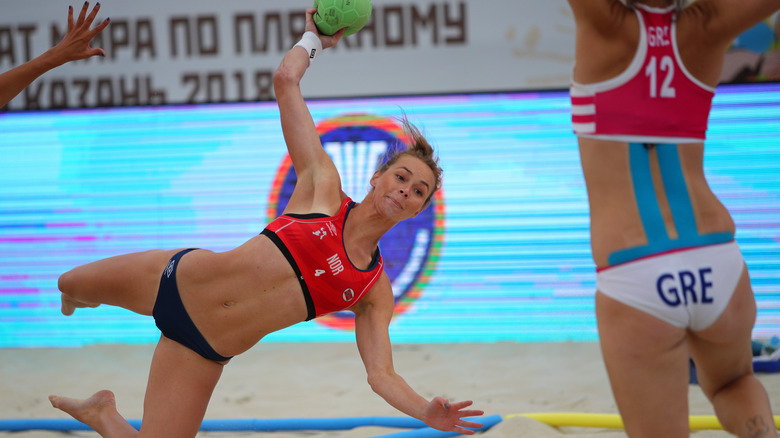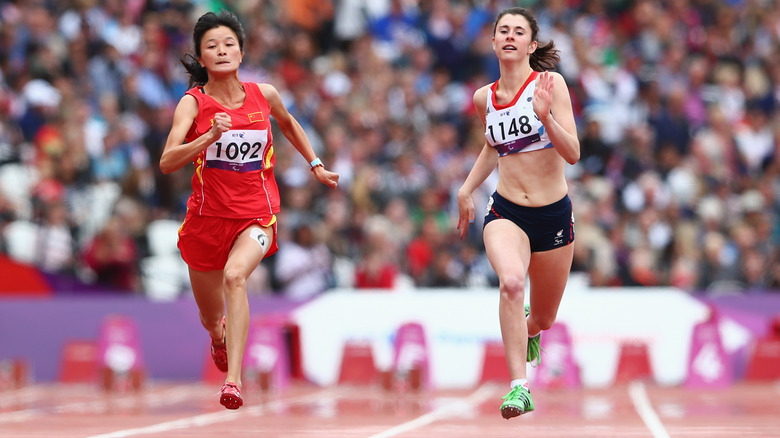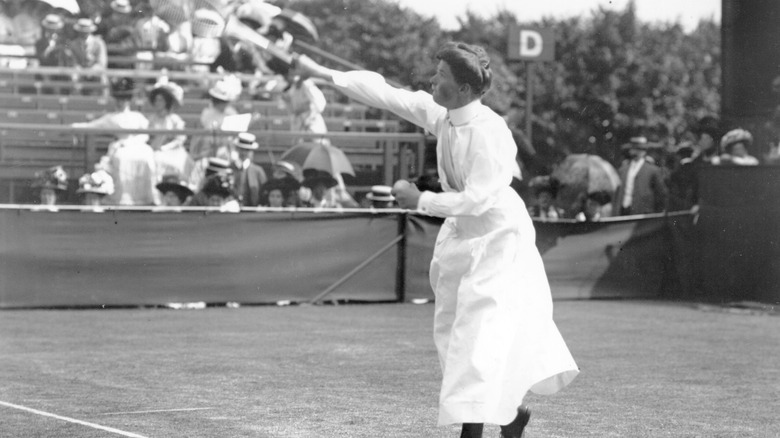The Real Reason Olympic Sports Have Strict Dress Codes
The phrase "dress code" might evoke strict high school uniform regulations, but it is something athletes must often contend with as well. Case in point: the Norwegian women's beach handball Olympic team made headlines on July 20, 2021, when they were fined for replacing the traditional bikini bottoms of their uniforms (shown above in the 2018 Olympic games) with shorts.
As reported by CNN, the European Handball Federation fined the team 1,500 Euros — 150 Euros per player — for "improper clothing," since the team members knowingly went against the uniform regulations laid out in the International Handball Federation Beach Handball Rules of the Game that requires female athletes to wear bikini bottoms with "a side width" that must be "a maximum of 10 centimeters (3.9 inches)," with a "close fit" and "cut on an upward angle toward the top of the leg." The male beach handball athletes, however, are required to wear shorts that fall 10 centimeters above the kneecap (although they "can be longer") so long as they are "not too baggy."
The Norwegian women's team's coach Eskil Berg Andreassen told CNN that the regulations might discourage women from taking up the sport and that the team was willingly accepting the fine after years of fighting for the right to choose shorts over bikini bottoms. Andreasssen pointed out that uniform regulations are "a difficult thing for many players" and that he was particularly concerned about women from majority Muslim countries choosing sports other than beach handball in order to avoid the bikini-bottom uniform requirement.
Too revealing or not revealing enough
The Norwegian women's beach handball team received props for their stance, with the Norwegian Handball Association tweeting their support for the athletes, saying, per CNN's translation, "We are very proud of these girls who during the European Championships raised their voices and announced that ENOUGH IS ENOUGH."
The team might breakthrough and get their wish to wear shorts some day; the IHF and EHF both said they "are committed to popularizing beach handball. All contributions in that respect and measures that will support the ambitions of this attractive sport are supported," according to CNN. The federations asserted that the topic of uniform requirements for females was spoken about at the April 2021 EHF Congress, and that the ongoing discussion would continue in August with the newly elected members of the Beach Handball Commission.
Sometimes regulations veer in the other direction though, with officials regarding female athletic attire as inappropriate because the outfit covers too little. Paralympic world champion Olivia Breen of Wales (shown above competing in the 2012 Paralympic Games) told CNN that she'd been "speechless" after being told at the English Championships that her sprint briefs were "too short and inappropriate." Breen said that she'd gone public with the exchange to raise awareness of the unfair scrutiny, stating, "You have no right to say what I can and can't wear," and noting that the briefs were specifically designed for competition and that she had worn similar ones for years without any other complaints.
A battle for more fair uniforms
Breen said to CNN that uniform regulations shouldn't make women feel self-conscious while playing sports. "When you are competing, you want to feel as light as possible to make you perform better," explained Breen, who asserted that wearing briefs rather than shorts made her feel "more free."
Olympic dress codes vary wildly for men and women, according to Bustle, which notes that 2016 was the first time designer Ralph Lauren, who has created the Olympic team uniforms for the United States since 2008, put both men and women in pants. In the past, the uniforms for women athletes had included skirts while the same men's uniforms worn for the Games' opening ceremonies offered pants. The article called this a step toward holding male and female athletes to the same standards by not "overtly sexualizing or othering" Team USA's women.
Other dress code difficulties faced by female athletes include the banning of Islamic headscarves, effectively barring some athletes from competition. In a regulation that has since been overturned, FIFA once banned uniforms with "any political, religious, or personal statements," which meant Iranian women couldn't compete in the 2010 Youth Olympic Games.
Women started qualifying for the Olympic Games in 1900, reported the BBC, making up 2% of the athletes. They competed in five sports, including tennis, where they played in long skirts to their ankles. Women fought to wear garb more suited for sports back then ... and they continue to do so.


